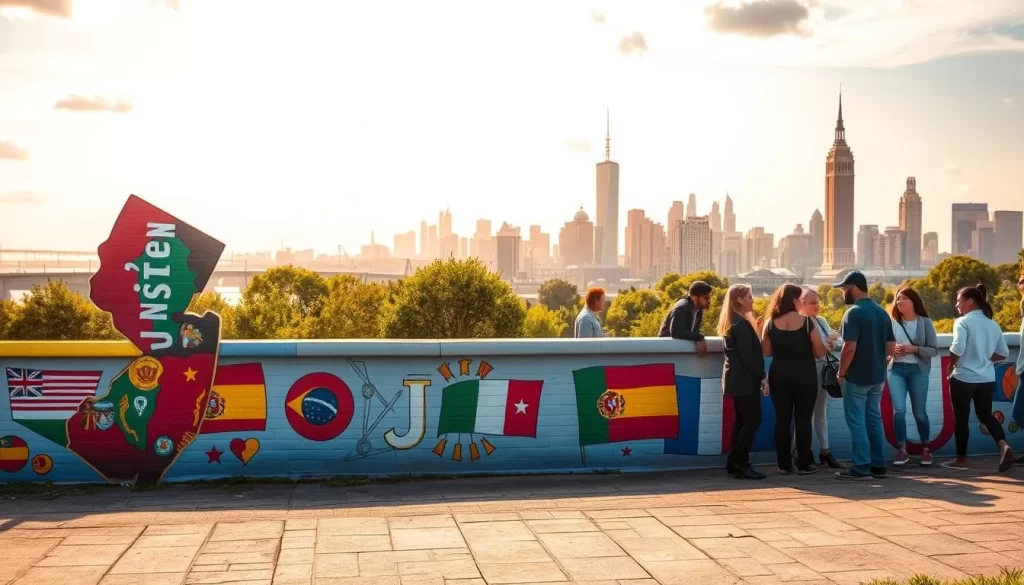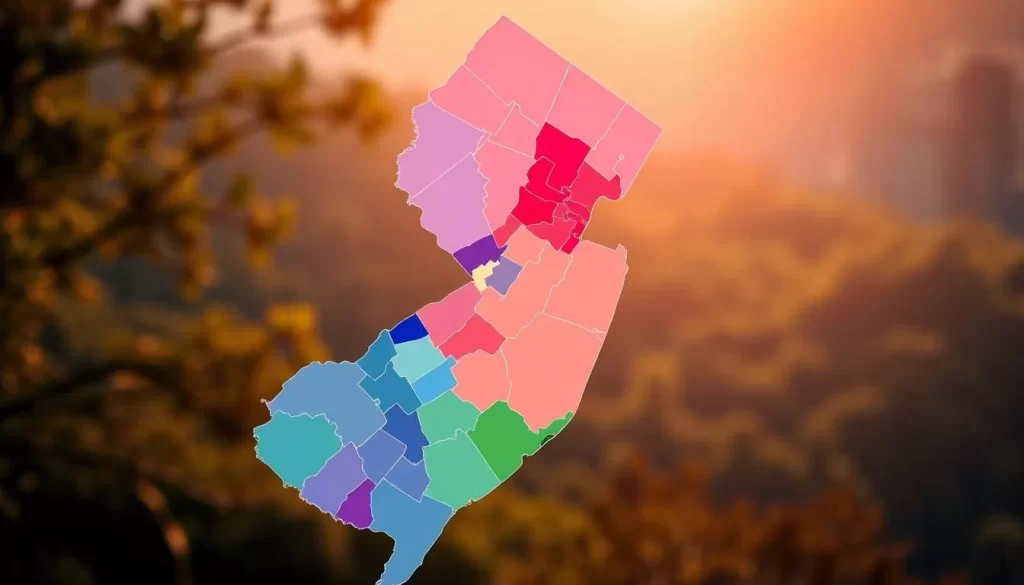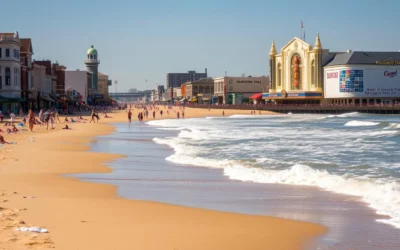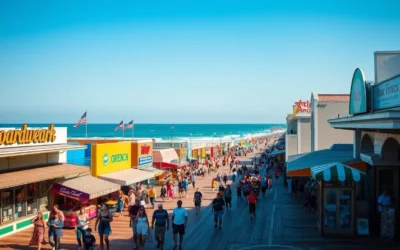✓ Accommodations ✓ Flights ✓ Rental Cars ✓ Tours & Activities
You’ll find that New Jersey is a melting pot of languages, reflecting its rich cultural heritage.
The state’s proximity to New York City and its historical role as an immigration gateway have shaped its unique linguistic landscape.
With over 30% of residents speaking a language other than English at home, New Jersey stands out as one of America’s most linguistically diverse states.
Understanding the languages spoken in this state provides valuable insights into its population‘s demographic composition and cultural diversity.
The Linguistic Landscape of New Jersey
As you explore the diverse communities of New Jersey, you’ll discover a rich linguistic landscape shaped by the state’s history of immigration. The population in New Jersey is mainly a reflection of immigration patterns during the 19th and 20th centuries.

Language Diversity in the Garden State
New Jersey ranks among the most linguistically diverse states in the country, with a rich tapestry of languages reflecting its immigrant history. The state’s language diversity stems from multiple waves of immigration dating back to the 19th century.
Immigration Patterns and Language Influence
The population of New Jersey has been shaped by various immigrant groups, including those from Germany, Russia, Ireland, and Italy, as well as many Slavic nations. During and after World War II, African Americans leaving the South also arrived in New Jersey in large numbers. The Hispanic population grew quickly during the 20th century, with immigrants from Cuba, Mexico, and Puerto Rico arriving.
Approximately 31.6% of residents aged five and older speak a language other than English at home. The proximity to New York City and Philadelphia has made New Jersey a natural settling place for immigrant communities seeking economic opportunities while maintaining cultural connections.
Official Language Status in New Jersey
New Jersey’s language landscape is shaped by its lack of an officially designated language. Unlike some states that have enacted “English-only” legislation, New Jersey takes a different approach.

English as the De Facto Official Language
You’ll find that English functions as the de facto official language in New Jersey, used for government operations, legal proceedings, and official documentation. When interacting with state government agencies, English is the primary language of communication, although translation services are increasingly available.
Language Policies and Regulations
The state’s language policies reflect a balance between recognizing English as the common language and acknowledging the linguistic diversity of its population. New Jersey’s educational policies require instruction in English, but the state also supports bilingual education programs. Court proceedings are conducted in English, with interpreter services provided for limited English proficient individuals.
English Language Usage in New Jersey
As you explore the linguistic landscape of New Jersey, you’ll find that English is the predominant language. The state’s language demographics reveal a diverse population with varying levels of English proficiency.
English-Speaking Population Statistics
Approximately 68.4% of New Jersey residents speak only English at home, which translates to a significant majority of the population. The English-speaking population is distributed across all counties, though urban areas tend to have higher concentrations of multilingual speakers.
Limited English Proficiency Demographics
Around 5.2% of New Jersey’s total population, approximately 462,202 residents, are considered to have limited English proficiency (LEP). This demographic requires language assistance to access essential services, highlighting the importance of language support in public services.

| Category | Percentage | Number of Residents |
|---|---|---|
| English-only speakers | 68.4% | Approximately 6.1 million |
| Non-English speakers at home | 31.6% | Around 2.75 million |
| Limited English Proficiency | 5.2% | Approximately 462,202 |
Spanish: New Jersey’s Most Common Non-English Language
Spanish is the most widely spoken non-English language in New Jersey, a fact that shapes the state’s cultural identity. As with most states, Spanish is in the lead by a significant margin. In total, around 16.35 percent of the population speaks Spanish, representing about 1,368,165 people.

Spanish-Speaking Communities in New Jersey
You’ll find that Spanish-speaking communities are concentrated in urban areas like Newark, Jersey City, Paterson, and Elizabeth, but extend throughout the state. The diversity of Spanish speakers reflects various origins, including Puerto Rico, Dominican Republic, Mexico, Cuba, and Central and South American countries.
Impact of Spanish on New Jersey Culture
The influence of Spanish extends beyond language into New Jersey’s cultural landscape. You can observe this impact in the state’s cuisine, music, festivals, and arts. Educational institutions have responded to the significant Spanish-speaking population by expanding bilingual education programs and Spanish language resources.
| Language | Speakers | Percentage of Population |
|---|---|---|
| Spanish | 1,368,165 | 16.35% |
New Jersey, United States: Official and Widely Spoken Languages Beyond English and Spanish
As you explore the languages spoken in New Jersey, you’ll discover a rich tapestry of linguistic diversity beyond the predominant English and Spanish. The state’s cultural melting pot is reflected in the many languages spoken by its residents.
Portuguese: The Third Most Common Language
Portuguese stands as the third most widely spoken language in New Jersey, with approximately 84,801 speakers, representing about 1.01% of the population. This reflects significant Brazilian and Portuguese immigration to the state.
Asian Languages in New Jersey
The Asian languages spoken in New Jersey form a significant part of the state’s linguistic diversity. Chinese (Mandarin and Cantonese) is the second most common non-English language, with around 119,892 speakers.
Chinese (Mandarin and Cantonese)
Chinese communities are concentrated in areas like Fort Lee and Edison.
Korean
Korean is another prominent language, with 75,298 speakers, particularly in Bergen County towns like Palisades Park and Fort Lee.
Gujarati and Hindi
Gujarati and Hindi, languages from India, are also widely spoken, with 80,552 and 79,659 speakers, respectively.
Tagalog
Tagalog, including Filipino, is spoken by approximately 75,711 people.
European Languages in New Jersey
Northern New Jersey is home to numerous European languages, reflecting historical immigration patterns.
Italian
Italian is spoken by 60,075 residents.
Polish
Polish is spoken by 59,210 residents.
Russian
Russian maintains a vibrant linguistic community.
French
French is also among the European languages spoken in the state.
Language Accessibility and Services in New Jersey
As you navigate the diverse linguistic landscape of New Jersey, you’ll find that language accessibility services play a crucial role. The state has taken significant steps to ensure that its services are accessible to everyone, regardless of their language proficiency.
Translation and Interpretation Services
You’ll find that New Jersey offers extensive translation and interpretation services across various sectors. State government agencies provide these services in multiple languages, with Spanish being the most widely supported. The New Jersey court system also uses certified interpreters to ensure language barriers don’t impede access to justice. Moreover, healthcare facilities are required to provide language assistance services under both state and federal regulations.
Multilingual Education Programs
The number of multilingual education programs has grown significantly in New Jersey schools. You can find bilingual education, ESL (English as a Second Language), and dual language immersion programs available in districts with high percentages of non-English speakers. These programs ensure that your children have the right to appropriate language support services, providing equal educational opportunities. Additionally, public transportation systems and community-based organizations offer language assistance and cultural integration services.
Conclusion
As a gateway state, New Jersey’s language landscape is characterized by a blend of languages spoken by its residents. You’ve gained insight into the state’s remarkable linguistic diversity, where over 30 percent of the population speaks a language other than English at home. The significant presence of Spanish speakers, who make up 16.35% of the population, highlights the importance of Hispanic communities in shaping New Jersey’s cultural identity.
The state’s linguistic diversity is further enriched by the presence of Portuguese, Asian languages, and European languages, showcasing New Jersey’s global connections. As you’ve discovered, the state continues to develop language accessibility services and educational programs to support its multilingual population, positioning it advantageously in an increasingly interconnected global economy.
The above is subject to change.
Check back often to TRAVEL.COM for the latest travel tips and deals.






